
Volume
26, No. 9 – September 2013
Volume 26, No. 9
Editor: Stephen L. Seftenberg
Website:
www.CivilWarRoundTablePalmBeach.org
President's Message
Happy Anniversary, Round Table!
We owe our inception to the vision and determination of Civil War
enthusiast, Robert (Bob) S. Godwin. In 1987 Bob secured a list of Palm
Beach County subscribers to the "Civil War Times." He personally
contacted each one and invited them to join a fledgling Round Table. Bob
was so excited to have three other people who shared his interest at the
first meeting on September 16, 1987. The charter members who attended
were Rodney Dillon, Bob Godwin, Joel Gordon, and Greg Parkinson.
Unfortunately, Bob Godwin and his lovely wife, Lillian, died tragically
in an auto accident on June 15, 1990 en route to Virginia Tech’s
"Campaigning with Lee" seminar.
I know that Bob would draw great satisfaction knowing that the Round
Table has grown to over sixty-five members, meets monthly, and will be
celebrating twenty-six successful years in Palm Beach County.
Eleven years ago I never expected to be writing the September, 2013,
President’s Message. I greatly appreciate the confidence you have in me.
Thank you to the members for all your assistance and guidance through
the years. Every time you volunteer or give financial support to the
Round Table, it makes us a stronger and more viable organization. In
this way the Round Table will continue to evolve and change with the
needs of the membership.
Gerridine LaRovere, President
September 11, 2013 Program
One of our favorite member-speakers, Janell Bloodworth, will
entertain and educate about "Emilie Todd Helm, President Abraham
Lincoln's Confederate Sister-in-Law."
August 10, 2013 Program
The Red River Campaign – "One Damn Blunder From Beginning to
End"
If someone not in the Roundtable were asked, "What was the largest
campaign in the American Civil War west of the Mississippi River?" the
response probably would be, "There were battles west of the
Mississippi?" True, these battles were not as famous as those in
Virginia or Pennsylvania or Tennessee or Georgia, but they were
important. In fact, the Red River Campaign, the Confederacy’s last major
victory, delayed the end of the war and destroyed a Union general’s
political career.
Steve pointed out that we actually have an embarrassment of riches
with respect to the Red River Campaign. In chronological order, oldest
is the Report of the Joint Committee on the Conduct of the War,
1863-1866 (U. S. Congress 1866), reprinted in 1977, 401 pages packed
with copies of original sources in very small print. Next, The Red
River Campaign – Politics and Cotton in the Civil War, a seminal
work by Professor Ludwell H. Johnson, Professor Emeritus of
History at The College of William and Mary, published in 1958 and
republished in 1995) which Steve used to outline his talk. Then comes
War Along the Bayous, by William R. Brooksher, U. S. Army Brigadier
General, Retired, published in 1998; followed by The Red River
Campaign and the Loss by the Confederacy of the Civil War, by
Michael J. Forsythe a then active U. S. army officer, published in 2002;
then came two related books, One Damn Blunder From Beginning to End
and Through the Howling Wilderness: the Red River Campaign and
Union Failure in the West, both by Gary D. Joiner, an associate
professor at Louisiana State University, and both published in 2006;
then Little to Eat and Thin Mud to Drink: Letters, Diaries, and
Memoirs from the Red River Campaign, 1863-1864, edited by Joiner,
published in 2007; and finally, Richard Taylor and the Red River
Campaign of 1864, by Samuel W. Mitcham, Jr., published in 2012,
another retired military man with over 40 books published.
They say that history is always written by the victors, but all of
the authors listed are or were Southerners and this sometimes shows in
the way they write. That is certainly true of Professor Johnson, who
has written extensively on the history of the Civil War, and who has
a distinctly pro-Southern tilt. At least one critic called his
body of work, "the Southern version" which attempts to "redeem the honor
of the Confederacy." The same critic said, "Johnson preferred Lee to
Grant as a military commander and Jefferson Davis to Lincoln as a war
president; and he saw the South as defending itself against an
aggressive North." In an earlier book, North Against South: The
American Iliad, 1848-1877, Johnson went so far as to contend that
the horrors of Reconstruction were but a continuation of atrocities
perpetuated during the war by Union armies. Nevertheless, Johnson’s book
accurately details all the reasons the Union saw for waging the
campaign.
Foremost was POLITICS: The year 1864 was an election
year and President Lincoln thought that if he could get Louisiana back
into the Union before the election in November, he could count on its
electoral votes.
Second was COTTON: Shreveport, Louisiana, and Northeast
Texas were major sources of cotton, which if it could be smuggled out by
blockade runners and sold to British textile mills, would pay for
armaments and supplies for the Confederacy. The textile mills in
Massachusetts and other New England states also wanted that cotton and
speculators with political connections smelled immense profits to be
gained by having the cotton confiscated as contraband and shipped
North.
Third and by no means least, was GEOPOLITICS: A
successful invasion would allow antislavery settlers to
flood Texas as they did in Kansas in the 1850's. Northern abolitionists
and other groups hoped to create ‘five or six’ free states out of the
single slave state of Texas.
 Finally,
there was FOREIGN POLICY: France had propped up
Maximillian as Emperor of` Mexico. Lincoln and his military strategists
feared the French might grab parts of Texas lost by Mexico in the
Mexican War for its Mexican puppet regime. Finally,
there was FOREIGN POLICY: France had propped up
Maximillian as Emperor of` Mexico. Lincoln and his military strategists
feared the French might grab parts of Texas lost by Mexico in the
Mexican War for its Mexican puppet regime.
The map shows the Theater of Operations. Three different
strategies were debated: U. S. Grant, commander of U. S. forces in the
West, wanted to shut the door on smuggling by taking Mobile, Alabama.
General Nathaniel P. Banks, who would command the invasion army,
preferred an amphibious landing at Sabine Pass and an advance toward
Houston and had even made a feeble and unsuccessful unauthorized landing
at Sabine Pass in September 1863. General-in-Chief Henry W. Halleck,
derisively nicknamed "Old Brains," however preferred moving up the Red
River to take Shreveport, and of course his views prevailed. By the time
Grant succeeded Halleck as General-in-Chief, the die had been cast and
the troops needed to take Mobile were already west of the Mississippi.
Halleck’s plan called for Banks to take 30,000 plus Union soldiers up
the Red River to Shreveport then west to Tyler, Texas, and Marshall,
Texas. Accompanying him was the largest Union naval force ever assembled
west of the Mississippi, under the command of Admiral David Dixon
Porter. What could possibly go wrong? Just about everything!
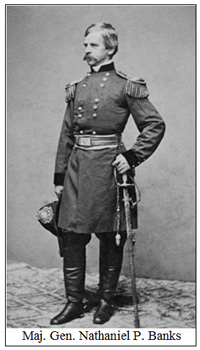 First
came Halleck’s blunder, which may have doomed the entire
enterprise to failure even before it started: he never named a supreme
commander (no one wanted Banks to be in charge and it is difficult to
imagine Banks taking orders from Porter). Instead Halleck "expected" the
two egotistical leaders to "cooperate." First
came Halleck’s blunder, which may have doomed the entire
enterprise to failure even before it started: he never named a supreme
commander (no one wanted Banks to be in charge and it is difficult to
imagine Banks taking orders from Porter). Instead Halleck "expected" the
two egotistical leaders to "cooperate."
It’s time to introduce you to the three major players in this story:
Nathaniel P. Banks, then 48 years old, was already a very popular
politician (Governor of Massachusetts 1858-1861), but had fallen short
of the Republican presidential nomination in 1860. After the war
started, Banks had been considered by Lincoln for a cabinet post but
instead was one of his first "political" generals. Banks hoped to use a
successful campaign as a springboard to nomination and election as
president in1864. Johnson alleges that Banks hoped to ship thousands of
bales of cotton back to Massachusetts, making himself a rich hero in the
process, while keeping cotton speculators with important political
connections happy. Johnson admits that Banks, with one exception did not
give the speculators any favors. The one exception came when President
Lincoln was duped into signing a note instructing Banks to do everything
in his power to help Samuel Casey, a former congressman and now a cotton
speculator. What Casey hoped to do may not have been entirely legal but
Banks had no choice but to give him free reign. In any case, Banks had
many reasons of his own both to go on this campaign one of which was to
make sure
 cotton
got back to Northern mills by hook or crook. Banks’ army was an
ill-suited combination of battle-hardened cocky Western troops, taken
from Sherman’s army, commanded by 48-year old Gen. Andrew Jackson Smith
and raw recruits from New England that Banks had recruited and brought
with him to New Orleans, commanded by 48-year old William Buel Franklin.
Both A. J. Smith and Franklin were West Point grads ("P’inters" as we
found out last month). There was little or no love lost between the two
Corps. Significantly, Franklin was part of Banks’ team, while A. J.
Smith was not. cotton
got back to Northern mills by hook or crook. Banks’ army was an
ill-suited combination of battle-hardened cocky Western troops, taken
from Sherman’s army, commanded by 48-year old Gen. Andrew Jackson Smith
and raw recruits from New England that Banks had recruited and brought
with him to New Orleans, commanded by 48-year old William Buel Franklin.
Both A. J. Smith and Franklin were West Point grads ("P’inters" as we
found out last month). There was little or no love lost between the two
Corps. Significantly, Franklin was part of Banks’ team, while A. J.
Smith was not.
Next on stage is Admiral David Dixon Porter, 51, son of a famous
naval hero, second man to be made an admiral, following his adoptive
brother, David G. Farragut, a midshipman at 10, victor in the capture of
New Orleans and leader of the Mississippi River Squadron that helped
Grant capture Vicksburg, Port Hudson and other Confederate positions so
the Mississippi, in Lincoln’s famous phrase, "could flow unvexed to the
ocean." It is significant to note that Porter hated politics and
politicians and this shadowed his relationship with Banks.
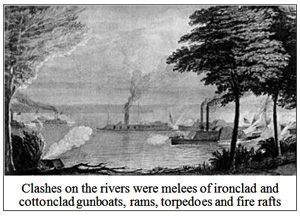 Porter’s
"brown water navy" consisted of more than 90 vessels (a "marvelous
mixture" of ironclads, river monitors, tinclads, timberclads, a ram and
support vessels), a separate Marine Brigade of 1,000 men and another
separate force under the Quartermaster with its own fleet. Porter wanted
all this firepower because he had word of Shreveport’s strong defenses,
including many Confederate ironclads and submarines. Porter’s
"brown water navy" consisted of more than 90 vessels (a "marvelous
mixture" of ironclads, river monitors, tinclads, timberclads, a ram and
support vessels), a separate Marine Brigade of 1,000 men and another
separate force under the Quartermaster with its own fleet. Porter wanted
all this firepower because he had word of Shreveport’s strong defenses,
including many Confederate ironclads and submarines.
Third to take the stage is Confederate Major General Richard Taylor,
only 38, a Harvard student who graduated from Yale, a member of the
famed Skull & Bones Society, a very rich Louisiana plantation owner, an
enlightened slave owner according to Frederick Law Olmstead, a skilled
politician, military historian, son of former President Zachary Taylor,
brother-in-law of President Jefferson Davis and the most popular
Confederate general west of the M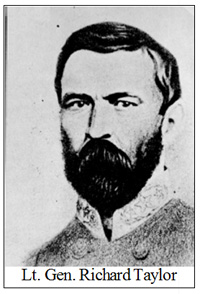 ississippi.
In the early stages of the war, Stonewall Jackson used Taylor's
"Louisiana Tigers" as an elite strike force in the Shenandoah theater.
When Taylor was promoted to Major General on July 28, 1862, he was the
youngest major general in the Confederacy. He was put in command of the
District of West Louisiana, with few troops or other war material.
Nevertheless, in a series of battles with Banks in Southern Louisiana,
he came close to recapturing New Orleans, but had to retreat when Port
Hudson was captured. ississippi.
In the early stages of the war, Stonewall Jackson used Taylor's
"Louisiana Tigers" as an elite strike force in the Shenandoah theater.
When Taylor was promoted to Major General on July 28, 1862, he was the
youngest major general in the Confederacy. He was put in command of the
District of West Louisiana, with few troops or other war material.
Nevertheless, in a series of battles with Banks in Southern Louisiana,
he came close to recapturing New Orleans, but had to retreat when Port
Hudson was captured.
Now for the campaign itself: After many delays that vexed President
Lincoln, the expedition got underway on March 10, 1864, with Franklin
marching north along the Red River from Port Hudson while Smith went
north aboard Porter’s troop ships. Banks and his army of over 32,000
faced Taylor, who initially had 7,000 or so men and never more than
8,800 men. Things went well at the start. Fort DeRussy, 20 miles south
of Alexandria, called the "Confederate Gibraltar," was the first
obstacle. However, as with Singapore in World War II, its guns faced the
river and its rear was poorly guarded. Attacking from the rear, A. J.
Smith captured the fort on March 14.
 By
March 31, Banks was in Natchitcohes (pronounced Nakaktish). At this
point Banks made the first of five blunders (shown on the
map to the right). Instead of continuing to drive northwest along the
Red River in conjunction with the U. S. Navy, Banks chose a narrow
inland stage coach road that ran from Grand Ecore through Pleasant Hill
and Mansfield before swinging north to Shreveport. This blunder meant
that he had to carry all of his own supplies and that he would be out of
touch with Porter’s gunboats. The source of this blunder, according to
Joiner, was a river pilot named Wellington W. Withinberry, who--to
protect his own cotton stored upstream--single-handedly sealed the fate
of the Union army by convincing Banks to move inland. (Joiner, One
Damn Blunder, xv). Joiner considers By
March 31, Banks was in Natchitcohes (pronounced Nakaktish). At this
point Banks made the first of five blunders (shown on the
map to the right). Instead of continuing to drive northwest along the
Red River in conjunction with the U. S. Navy, Banks chose a narrow
inland stage coach road that ran from Grand Ecore through Pleasant Hill
and Mansfield before swinging north to Shreveport. This blunder meant
that he had to carry all of his own supplies and that he would be out of
touch with Porter’s gunboats. The source of this blunder, according to
Joiner, was a river pilot named Wellington W. Withinberry, who--to
protect his own cotton stored upstream--single-handedly sealed the fate
of the Union army by convincing Banks to move inland. (Joiner, One
Damn Blunder, xv). Joiner considers
Banks’ refusal of either a naval or cavalry reconnaissance up the
river "is unforgivable" (Joiner, Through the Howling Wilderness,"
p. 76). From the beginning of the Red River Campaign, Taylor could only
delay the Union advance, but Taylor had a surprise waiting for Banks and
his men once they left the river and were approaching Mansfield.
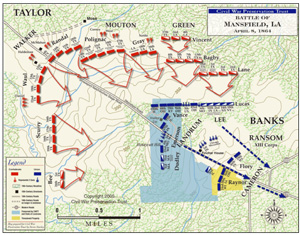 On
April 8, 1864, Taylor, with 8,800 men, surprised the head of Banks'
20-mile long column, driving the Yankees back with heavy casualties and
capturing many supply wagons before stopping due to the darkness. Banks
was able to commit no more than 12,000 of his 32,000 men and Taylor was
able to outnumber them at every important point of contact. A look at
the map of the battle shows this. The rest of the Union troops were
toiling through dust and mud miles behind and missed the battle. This
battle’s outcome was determined by a series of additional blunders by
Banks. Bank’s second blunder was to "accept battle at the
head of a column 20 miles long at the hands of an enemy formed in
complete order of battle, in a position previously chosen by the enemy,
and where Banks’ artillery could not On
April 8, 1864, Taylor, with 8,800 men, surprised the head of Banks'
20-mile long column, driving the Yankees back with heavy casualties and
capturing many supply wagons before stopping due to the darkness. Banks
was able to commit no more than 12,000 of his 32,000 men and Taylor was
able to outnumber them at every important point of contact. A look at
the map of the battle shows this. The rest of the Union troops were
toiling through dust and mud miles behind and missed the battle. This
battle’s outcome was determined by a series of additional blunders by
Banks. Bank’s second blunder was to "accept battle at the
head of a column 20 miles long at the hands of an enemy formed in
complete order of battle, in a position previously chosen by the enemy,
and where Banks’ artillery could not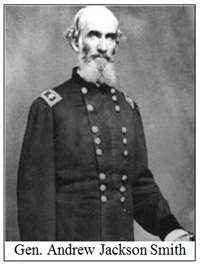 be used because of the trees in the way" and before he could organize
his army. Banks was impatient and ordered his cavalry commander, Albert
Lee, to charge unassisted across an open field into hidden rebel guns.
Only Lee’s adamant refusal to obey this suicidal order kept this battle
from being a total rout before it really even started. Banks’
third and most serious blunder had been to set the order of
march with the cavalry in front, "followed immediately by 300 wagons at
Franklin’s insistence so as not to delay his own supply train." Then
came 2,500 U. S. Colored Troops to guard the wagon train. Then came
Franklin’s 15,000 infantry. Then came 700 more wagons. Finally came A.
J. Smith’s 7,500 angry veterans. The red clay stage road was so narrow
the men could not march more than 4 abreast and was either a dust storm
when dry or slippery muck when wet. One Union cavalryman called the area
"a howling wilderness." Most of the supply wagons were captured by the
rebels when the Union teamsters beat a hasty retreat. Banks and Franklin
failed to see that the two
be used because of the trees in the way" and before he could organize
his army. Banks was impatient and ordered his cavalry commander, Albert
Lee, to charge unassisted across an open field into hidden rebel guns.
Only Lee’s adamant refusal to obey this suicidal order kept this battle
from being a total rout before it really even started. Banks’
third and most serious blunder had been to set the order of
march with the cavalry in front, "followed immediately by 300 wagons at
Franklin’s insistence so as not to delay his own supply train." Then
came 2,500 U. S. Colored Troops to guard the wagon train. Then came
Franklin’s 15,000 infantry. Then came 700 more wagons. Finally came A.
J. Smith’s 7,500 angry veterans. The red clay stage road was so narrow
the men could not march more than 4 abreast and was either a dust storm
when dry or slippery muck when wet. One Union cavalryman called the area
"a howling wilderness." Most of the supply wagons were captured by the
rebels when the Union teamsters beat a hasty retreat. Banks and Franklin
failed to see that the two
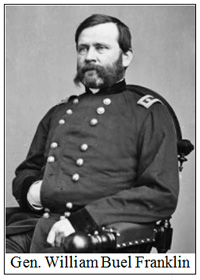 wagon
trains would box in Franklin’s infantry, hindering both their advance
and their retreat. Joiner, in Through the Howling Wilderness, p
77-79, notes a fourth blunder by Banks: "Banks’ use of
only one road set the stage for disaster. His failure to have his
cavalry fan out ahead and seek other routes qualifies as one of the
greatest blunders of the Civil War." By all accounts, the Battle of
Mansfield was "one of the most humiliating Union defeats of the war." wagon
trains would box in Franklin’s infantry, hindering both their advance
and their retreat. Joiner, in Through the Howling Wilderness, p
77-79, notes a fourth blunder by Banks: "Banks’ use of
only one road set the stage for disaster. His failure to have his
cavalry fan out ahead and seek other routes qualifies as one of the
greatest blunders of the Civil War." By all accounts, the Battle of
Mansfield was "one of the most humiliating Union defeats of the war."
A dirty little secret must be revealed about Taylor’s forces – a
substantial portion of his army consisted of parole violators – veterans
who had surrendered at Vicksburg and Port Hudson. What they were doing
was highly illegal and the punishment for their crime was death. They
apparently had no homes to go home to and the Southern officers and men
quietly welcomed them into their ranks.
The next day, April 9, Taylor attacked Banks at Pleasant Hill.
Technically Taylor lost the battle because of the solid stand of A. J.
Smith's men, but this battle put an end to the campaign because Banks
now commits a fifth and final blunder that sealed the fate
of his political hopes by retreating that night, instead of regrouping
and attacking in the morning. Steve stated that he had no doubt that if
Grant or Sherman (or A. J. Smith) had been in command, he would have
attacked the next morning and probably prevailed. Edward Kirby Smith,
40, another P’inter, and as commander of the Confederate Department of
the Trans-Mississippi, reported to President Davis after the battle that
Taylor’s forces had been "repulsed and were broken and scattered and
completely paralyzed" and had Banks attacked, he very well could have
walked to Shreveport. A. J. Smith, as noted before, not part of Banks’
inner circle, agreed with Kirby Smith and confronted Banks, contending
that the Union army should follow up its victory, but Banks would not
change his mind. A. J. Smith then asked Franklin to weigh in but
Franklin would not do so. A. J. Smith even suggested that Franklin
arrest Banks and take over command. Franklin said, "Smith, don’t you
know this is mutiny?" Smith silently left to carry out his orders. The
Union soldiers could not believe a retreat had been ordered and
serenaded Banks, chanting:
"In 1861, we all skedaddled to Washington.
In 1864, we all skedaddled to Grand Ecore."
 In
a confidential letter to Secretary of the Navy Gideon Wells dated April
28, 1864, Admiral Porter bluntly agreed with the soldiers: "The only man
here who possesses the entire confidence of the troops is General A. J.
Smith, and if he were placed in command of this army he would, I am
convinced, retrieve all its disasters." [Joint Committee Report,
page 253] In
a confidential letter to Secretary of the Navy Gideon Wells dated April
28, 1864, Admiral Porter bluntly agreed with the soldiers: "The only man
here who possesses the entire confidence of the troops is General A. J.
Smith, and if he were placed in command of this army he would, I am
convinced, retrieve all its disasters." [Joint Committee Report,
page 253]
At this point Kirby Smith, Taylor’s superior officer, may have saved
Banks and Porter from total defeat by taking most of Taylor's troops
away to defeat Union General Frederick Steele's movement south from
Little Rock, Arkansas towards Shreveport. Taylor was furious, believing
that Banks' troops were demoralized and ripe for capture. The
disagreement festered and led to Taylor's transfer shortly after the end
of the campaign.
The Union retreat from Pleasant Hill to Alexandria was not a pleasure
trip because of the loss of the supply train and constant attacks by the
Confederate cavalry. In a letter dated May 4, 1864, Union Private Thomas
Hayden wrote a letter to a friend in which he says, "Pleasant Hill was
not exactly a victory for us. Gen. Banks thought he had seen
enough of that part of the country so, April 21, we began the great
retreat to Alexandria. We marched day and night, with the rebs all round
us, fighting all the time. It was an awful hard march, Jim. Little
to eat and thin mud to drink. We arrived at Alexandria
Apr. 26, all tired out. Soldiering out here is no joke." [Little to
Eat and Thin Mud to Drink, p. 179-80.]
Porter, 51, had committed his own almost fatal blunder
by steaming North of the rapids at Alexandria with all his vessels,
putting the most heavily armed vessels with the most draft first in
line. Many of Porter’s gunboats and troop ships needed 7 feet of water
but the river at Alexandria was often less than 3 feet deep. Porter
repeatedly bragged that he could take his fleet "wherever the sand was
damp." [One Damned Blunder p 67] Once Banks began his hasty
retreat from Pleasant Hill, Porter began a slow retreat down a river
with not enough water and too many sandbars. Taylor tried repeatedly to
cut off the Union navy’s retreat Capt. Thomas O. Selfridge testified to
the Joint Committee that "the return of the fleet was fraught with
peril." [Forsythe, The Red River Campaign, page 90]. As noted a
moment ago, Taylor’s thinned-out forces harassed Banks’ hungry troops,
but Banks was able to retreat over 90 miles to Alexandria. He could go
no farther because most of Porter’s squadron was trapped north of
the rapids! Banks, under orders from Grant, could not desert
Porter here because the Confederates would have sunk or captured the
entire squadron.
 An
ingenious Wisconsin engineer, Col. Joseph Bailey, using skills learned
in floating logs down rivers in lumbering operations, rescued Porter
from potential disaster with what has been labeled as "one of the most
imaginative engineering feats in military history." Taking 3,000 men
Bailey built a dam over 700 feet wide in just 10 days, using nothing but
trees, rocks, bags of dirt and hundreds of bales of confiscated
cotton, then sank four barges filled with stone to fill the gap and
raise the level of the river. The dam lasted just long enough to let the
Union vessels go roaring down the river to safety. A contraband watching
from the shore said, "Before God, what won’t the Yankees do next?" With
the navy no longer in jeopardy, Banks was free to continue his retreat.
Taylor’s diminished force could harass and continue inflicting
casualties on the Union soldiers and sailors, but he lacked the manpower
to block and defeat them. Taylor made two last efforts to stop Banks, at
Mansura on May 16 and at Yellow Bayou on May 18, but the Union army was
able to retreat across the Atchafalaya River to safety. An
ingenious Wisconsin engineer, Col. Joseph Bailey, using skills learned
in floating logs down rivers in lumbering operations, rescued Porter
from potential disaster with what has been labeled as "one of the most
imaginative engineering feats in military history." Taking 3,000 men
Bailey built a dam over 700 feet wide in just 10 days, using nothing but
trees, rocks, bags of dirt and hundreds of bales of confiscated
cotton, then sank four barges filled with stone to fill the gap and
raise the level of the river. The dam lasted just long enough to let the
Union vessels go roaring down the river to safety. A contraband watching
from the shore said, "Before God, what won’t the Yankees do next?" With
the navy no longer in jeopardy, Banks was free to continue his retreat.
Taylor’s diminished force could harass and continue inflicting
casualties on the Union soldiers and sailors, but he lacked the manpower
to block and defeat them. Taylor made two last efforts to stop Banks, at
Mansura on May 16 and at Yellow Bayou on May 18, but the Union army was
able to retreat across the Atchafalaya River to safety.
This ended the campaign. When pressed for his opinion, General
William Tecumseh Sherman called it "one damn blunder from beginning
to end." Steve added: militarily, politically and
economically.
The Federals left a path of destruction in their wake, burning houses
and barns and stealing or killing livestock all the way south from Grand
Ecore and even leveling Alexandria by firing the town. Johnson singles
out A. J. Smith’s battle-hardened westerners (called "gorillas" by the
rebels) as the main culprits, though the less-experienced Easterners
recruited by Banks did their share of mischief. In addition, the
Confederates burned the cotton rather than letting it fall into Union
hands. In any event, the residents had to choose between fleeing and
starving and preserved their resentments against Yankees for
generations.
Professor Johnson argues that the Red River campaign was
"unnecessary," that it delayed the end of the war and that it ran up the
war’s cost in blood and money. Banks' inglorious expedition tied up as
many as 20,000 veteran soldiers who could have been better used to
reinforce Sherman's army against Atlanta or to attack Mobile, as Grant
wanted. Instead, these men were stuck west of the Mississippi, allowing
General Polk and 20,000 rebels to leave Mobile to help Joe Johnston
defend Atlanta.
The army under Banks and the navy under Porter failed to cooperate as
Halleck had hoped they would, and instead often competed in a race to
seize cotton. Even here the campaign was a failure because most of the
cotton Banks had hoped to glean was burned on the approach of the
Federals or lost in the hasty retreat from Grand Ecore. And the project
of making free states out of Texas disappeared with the Union army’s
retreat. Lastly, Banks' Presidential hopes were also crushed by his
humiliating failures during the campaign. President Lincoln relieved him
of field command and returned him to Washington, D. C., to lobby for the
president’s Reconstruction program.
Now the Radical Joint Committee on the Conduct of the War jumped in
to "investigate" the "disastrous" campaign and "Banks joined the unhappy
company of men who were subjected to the prejudicial scrutiny of Ben
Wade and his colleagues." "Any evidence tending to reflect discredit on
the administration was welcome" and Lincoln’s alleged connection to
cotton trading was fodder for the enemies of Lincoln’s Reconstruction
plans. Also of interest to the committee were stories of swarms of
speculators accompanying the army and allegedly enjoying the assistance
and protection of Banks.
Admiral Porter testified that "the whole affair was a cotton
speculation . . . a big cotton raid." Porter and the committee
conveniently ignored the fact that "wherever cotton was found, [the
navy] seized it." Not for nothing was Porter given the nom de guerre
"The Thief of the Mississippi." Johnson concluded that "Banks gave
no one who accompanied the expedition any special trading privileges. .
. . Of course, when Samuel L. Casey and William Butler" (the shady
brother one of my favorite Civil War characters, Benjamin Franklin
Butler) "appeared with a pass bearing Lincoln’s signature, Banks was
obliged to give them a free hand." One witness fabricated an absurd tale
that Gov. Richard Yates of Illinois (one of Lincoln’s best friends) had
gone to New Orleans as part of a scheme concocted by Yates and Banks to
make the latter President by raising a slush fund trading in cotton
which would be used to buy the nomination of Banks.
Porter’s postwar career bloomed under President Grant and he did much
to reform the Naval Academy and naval policy, but soon rubbed too many
important people the wrong way with his brusque manner and total lack of
political savvy. By 1868 he had been put out to pasture.
On the Confederate side, Taylor was an excellent general and his
ideas for pursuing Banks made more sense than Kirby Smith's decision to
block Steele’s move south from Arkansas. Nathan Bedford Forest said: ".
. .if we’d had more like him, we would have licked the Yankees long
ago." After the war, he moved to New York and wrote his much-praised
memoirs, "Destruction and Reconstruction," became active in Democratic
Party politics and opposed Radical Reconstruction.
Finally, both armies joined to lay waste a good portion of Western
Louisiana which did not recover for many decades. The population
harbored great animosity toward the Federal government and the
Republican Party for generations.
Forsythe, something of a contrarian, contends that the Red River
Campaign was "one of the most successful campaigns conducted by any
Confederate army during the Civil War. . . . Through sheer audacity and
superior leadership, General Taylor turned back the invaders, driving
them all the way to the Mississippi River. In the process, the
Confederates . . . [captured] a huge supply train, dozens of field guns,
thousands of stands of small arms and over a thousand prisoners. [As a
result,] the Rebel government was able to maintain territorial integrity
of the region west of the Mississippi until the very last days of the
war." [Forsythe, 119-123] Forsythe contends that it might
have been possible, had Taylor been allowed to wipe out Banks and
Porter, that the election of 1864 might have elected
McClellan, leading to a peace treaty. The odds against this theory are
almost prohibitive.
In the end, a military campaign conceived for non-military reasons
ended up hurting other Union campaigns that were far more important to
prosecution of the war. The Red River campaign is "a study in how
partisan politics, economic need and personal profit can determine
military policy and operations. It is also a story of inept military
operations in a tactically useless theater of operations, an operation
in which the Union Army was nearly annihilated and the Union River Navy
was almost sunk or captured intact. A side effect was to delay the end
of the war. Blunder does not begin to connote the foolishness of this
campaign. It was a short operation, lasting from only March 12 to May
20, but wound up being one of the most destructive of the entire war."
Ironically, the Red River Campaign had several beneficial
aftereffects: army and navy operations became truly "combined"
under a single commander instead of relying on cooperation between two
equally egotistical commanders. Bailey’s dam was a brilliant adaptation
of logging industry techniques. And, for the first time, Capt. Thomas O.
Selfridge, Jr., aimed a gun using a periscope invented a few days
earlier on board his vessel that succeeded in killing a Confederate
general and staff. Selfridge, who commanded the U. S. S. Monitor for
four days, served with distinction throughout the war and ended up an
admiral in charge of the Pacific Fleet, is included, primarily because
one of my Chicago law partners was reputedly a descendant of his!
Finally, and most importantly, the navy learned not to take large
vessels into tight quarters and instead developed vessels that evolved
into the famous Swift Boats used in the Vietnam war. [One Damned
Blunder, pages 174-75].
A question and answer session, followed by well-earned applause,
ended the evening.
# # #
Last changed: 09/09/13
Home
About News
Newsletters
Calendar
Memories
Links Join
|

